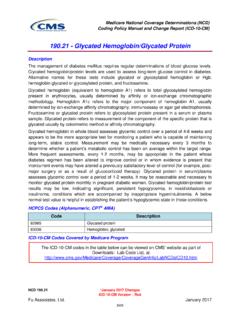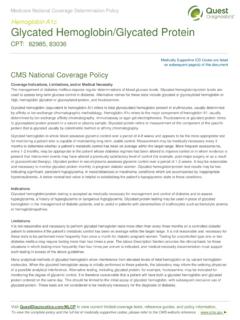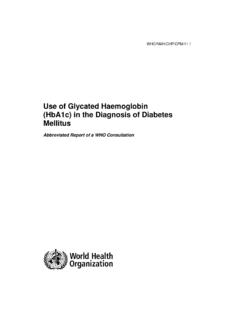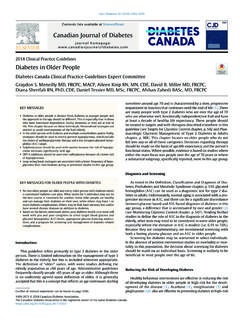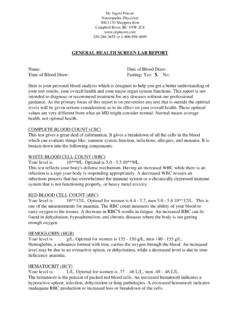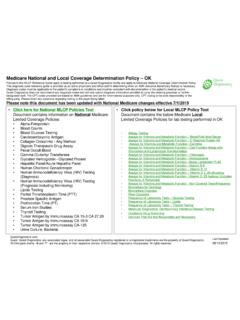Transcription of EXPLANATION OF LABORATORY BLOOD TESTS
1 FREMONT AREA MEDICAL CENTER. WELLNESS SCREENING. EXPLANATION OF LABORATORY BLOOD TESTS . The following is a brief EXPLANATION of the BLOOD TESTS that You did not fast for the appropriate amount of time are o ered in the Wellness Screenings performed by FAMC. before having your BLOOD drawn Results that are outside of the reference or normal range are agged with either H for high values or L for low values. You may be taking medication that may a ect your results Values that fall outside of the normal reference ranges may be due to the presence of disease, or many other factors to include: You should contact your physician if you have any results that fall outside of the normal range, or if you have any questions Statistically, when a normal overall healthy population is about any of your test results. screened, some results should fall outside of the normal range HEMATOLOGY. WHITE BLOOD CELL COUNT (WBC) measures the protein in one's red cells and abnormalities will almost always number of white BLOOD cells in the BLOOD .
2 They may be re ect abnormal results in hemoglobin, hematocrit, red BLOOD elevated in infection and leukemia, and low in bone mar- cell count, or mean corpuscular volume. row damage due to chemicals, drugs, etc. and, at times, with infection. You should contact your physician for signi cant MEAN CORPUSCULAR HEMOGLOBIN CONCEN- abnormalities. TRATION (MCHC) measures the concentration of hemo- globin in the red BLOOD cells. It is low in iron de ciency and RED BLOOD CELLS (RBC) are responsible for trans- some other anemias. It can only be high if the red BLOOD cells porting oxygen to the tissues of the body. A decrease in the are abnormally shaped, as spheres. Abnormalities will almost number of RBC's is called anemia; an increased concentra- always be associated with other abnormal results. tion is called polycythemia. RED CELL DISTRIBUTION WIDTH (RDW) is a nu- HEMOGLOBIN (HGB) and HEMATOCRIT measures merical expression of red BLOOD cell size. the amount of red BLOOD cells in the BLOOD .
3 Low levels may indicate anemia. Higher-than-normal values can be found PLATELET (PLT) Mature platelets are the third cellular ele- in other diseases, such as polycythemia vera. ment in the circulating system and have a continual function to maintain vascular integrity. If platelets are absent from the MEAN CORPUSCULAR VOLUME (MCV) is a measure circulation, red cells migrate through the vessel walls in large of the size of the red BLOOD cells. Small cells are seen in iron numbers. In addition, platelets play a major role in the clot- de ciency and some hereditary defects, both usually associ- ting process. ated with anemia. Large cells are seen in rapid replacement of red BLOOD cells by the bone marrow, and in the anemia MEAN PLATELET VOLUME (MPV) is a measure of the due to some vitamin de ciencies. Your physician should average volume of the platelets in a sample. evaluate both. (continued). MEAN CORPUSCULAR HEMOGLOBIN (MCH) is a measure of the amount of hemoglobin, the oxygen-carrying CHEMISTRY.
4 SODIUM (NA), POTASSIUM (K), and CHLORIDE (CL) TRIGLYCERIDES (TRIG) are another type of BLOOD lipid are mineral elements in the BLOOD primarily controlled by the (fat). Triglycerides represent the storage form of lipid in the adrenals and kidneys. Abnormalities may suggest dehydra- body. Triglyceride levels are often elevated if you have eaten tion, kidney disease, adrenal disease, vomiting, diarrhea, or within 12 hours of getting your BLOOD drawn. some other metabolic disorder. Abnormal potassium levels may signi cantly a ect skeletal and heart muscle and nerve HIGH DENSITY LIPOPROTEIN CHOLESTEROL. function. With marked abnormalities you should consult (HDL) is a fraction of BLOOD cholesterol. It is considered your physician. Patients taking diuretics (water pills) often to be the good cholesterol and higher levels are desirable. get low potassium levels and should de nitely contact their Increased levels of HDL are thought to reduce the risk of physician if the potassium is mg/dl or less.
5 Arteriosclerosis (clogging of the arteries) and heart disease. TOTAL CARBON DIOXIDE CONTENT (TCO2) is LOW DENSITY LIPOPROTEIN (LDL) is another frac- formed in the tissue and eliminated by the lungs. TCO2 and tion of BLOOD lipids (fats). Low levels of LDL are desirable. the carbonates assist in maintaining the neutrality of the tis- Increased LDL levels can lead to the development of arterio- sue and uids in the body. sclerosis because it deposits on the walls of the BLOOD vessels. GLUCOSE (GLU) is a measure of your BLOOD sugar level. CHOLESTEROL/HDL RATIO (RISK FACTOR) is a It is often used to screen for diabetes which is a condition calculation that indicates potential risk for heart disease. This characterized by a higher than normal BLOOD sugar level. Your calculation is performed by dividing the total cholesterol by glucose level may be higher than normal if you have had the HDL value. anything to drink (except water) or ate shortly before having your BLOOD drawn.
6 ALKALINE PHOSPHATASE (ALP) is an enzyme found in bone, liver, intestines, and placenta. It is elevated in children, CREATININE (CREAT) AND BLOOD UREA NITRO- following severe exercise, or when there is bone injury. It is GEN (BUN) are waste products primarily excreted by the characteristically high when there is obstruction of the ow kidneys. BUN may be slightly elevated in people on a high of bile out of the liver. Mildly elevated values can probably be protein diet or who have exercised heavily. Both tend to be ignored, and low values are not of signi cance. You should elevated in kidney disease and if either is elevated signi cantly, consult your physician if signi cantly elevated, or if AST or or if both are elevated, you should consult your physician. ALT are also elevated Low values are not of signi cance ALANINE AMINO TRANSFERASE (ALT, SGPT), AND. BILIRUBIN, TOTAL AND DIRECT (T. BILI AND D. ASPARTATE AMINO TRANSFERASE (AST, SGOT) are BILI) is a pigment from the breakdown of red BLOOD cells, enzymes which function in the use of food by the body and which is broken down and excreted by the liver.
7 It may be especially the liver. ALT is essentially found only in the liver elevated with increased red BLOOD cell breakdown or liver while AST is found in the liver and skeletal and cardiac mus- damage. The direct bilirubin is the form excreted by the liver cle. When those cells are injured, these enzymes escape into and is elevated when bile excretion is obstructed. You should the BLOOD . Mild AST elevations are often seen in alcoholism, consult your physician for elevated values, especially if ALT, but mild elevations of either may probably be ignored. Low AST, or Alkaline Phosphatase is also elevated. Low values are values are not of signi cance. You should consult your physi- not of signi cance. cian for signi cant elevations, or if more than one enzyme (AST, ALT, Alkaline Phosphatase, or LDH) is elevated. CHOLESTEROL (CHOL) is a BLOOD lipid (fat) that helps to synthesize or create the body's hormones. Cholesterol CALCIUM (CA) is a mineral in the BLOOD controlled by the levels can vary a great deal in healthy individuals changes of parathyroid glands and kidneys and is mainly involved in up to 50 mg/dl within a few hours have been found in some bone formation.
8 Calcium is important is skeletal and cardiac individuals. muscle function, nerve function, and BLOOD clotting. Cal- (continued). cium varies in the same way as marked changes in albumin. nutrition or kidney disease. High total protein values may You should de nitely consult your physician for any elevated suggest some disease with an abnormal immune response or calcium. some tumors (myeloma). PHOSPHORUS (PHOS) is a mineral in the BLOOD whose URIC ACID (UA), is a waste product excreted in urine. concentration is closely linked with that of calcium because High values are characteristic of gout, but may be seen in ar- they are both deposited together in the bone. Phosphorus thritis, kidney disease, and massive breakdown of cells in the concentrations are increased in kidney disease, certain thyroid body. Signi cantly high values should be evaluated by your conditions, and in infants and children because of increased physician, but low values are probably not of signi cance.
9 Levels of growth hormone. Decreased levels occur with chronic ingestion of antacids, rickets, and in other types of B/C, A/G these are mathematical relationships of (BUN. thyroid disease. and Creatinine), (Albumin and Globulin) and are signi cant only in abnormal conditions. These are not important in the TOTAL PROTEIN (TP) and ALBUMIN (ALB) measures screening situation. the major proteins in your BLOOD . Low values suggest poor PSA AND TSH. PSA, or Prostate Speci c Antigen, is a protein that is pro- TSH, or Thyroid Stimulating Hormone, will identify and/or duced by the normal prostate gland and produced by most monitor an underactive or overactive thyroid condition. You prostate cancers. An elevated level of PSA (greater than 4 should consult your physician with any abnormal results. ng per millimeter), however, is a de nite indication that you should see your physician for a thorough history and physi- cal examination, including a thorough examination of the prostate gland.
10 GLYCATED HEMOGLOBIN. Glycated Hemoglobin (HgbA1C or A1C), a test that measures the percentage of total hemoglobin in your BLOOD that has glucose attached to it. This test is an average BLOOD glucose over a two or three month period of time. A test used for diabetes management. Fremont Area Medical Center LABORATORY 450 East 23rd Street Fremont, NE 68025. (402) 727-3742.
